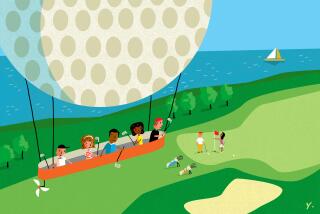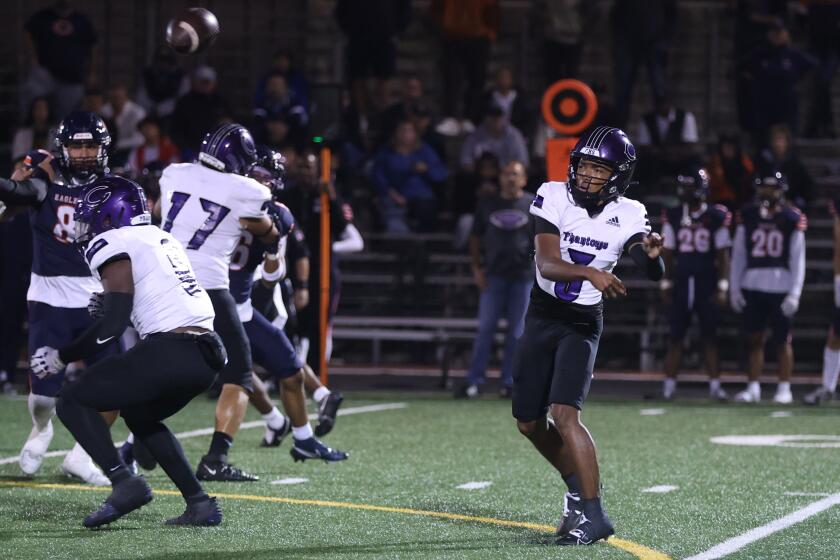A Slugger, Right From the 1st Tee
- Share via
MURRIETA, Calif. — Nobody ever played golf the way Arnold Palmer did.
Arnold Palmer played golf the way Dempsey fought, the way Ruth hit, or the way a tiger hunted.
There was something primal about Arnold Palmer on the spoor of a golf championship, something that stirred emotions the way cowboy heroes did in the Saturday afternoon serials. Splendor in the grass. The perils of Palmer were as exciting as any ever concocted for Pearl White. He made everybody else on the leader board a villain. His defeats were tragedies, his victories everybody’s.
He was America’s Team long before the Dallas Cowboys were.
He turned a golf round into Dempsey-Firpo. A war. He didn’t play a course, he invaded it. He waded into it like a guy jumping through a skylight with a Luger. He wasn’t Ben Hogan, he was Hulk Hogan.
No one had ever gone around a course like this before. Not Snead, Hogan, Jones, Hagen, Harry Vardon. Not even Jack Nicklaus would. Sam Snead had this sweet swing you could pour on waffles. Hogan treated the course with the cold contempt of an executioner. Jones relied on elegant shotmaking.
There was nothing elegant or sugary about Palmer’s method. Arnold’s approach was passionate. His shirt came out, his hair got mussed, his pants wrinkled. Arnold mugged a course, he didn’t romance it. Arnold made a 2 or a 12. He wasn’t interested in self-defense.
He looked and acted like an athlete. He was strong enough to hit a ball out of the Pacific Ocean, and did. He could go in the rough and smash a ball out off debris so thick that the ball, chunks of rock, cans, bottles, a few squirrels, tree trunks and parts of old Volkswagens would come flying out together. And most of them landed on a green.
He paced a course like a predatory animal. He was tireless. Whenever a tournament took five rounds or 36 holes, Palmer was a four-hole favorite.
He loved the game. Watching Palmer play golf was like watching Willie Mays play center field. It wasn’t a game, it was a love affair. They were made for each other.
The Scots invented the game, but Palmer popularized it. He brought the truck drivers in. He took it out of Long Island and Palm Beach and put it on the Pennsylvania Turnpike. Palmer was lucky there was golf, but golf was lucky there was Palmer. Babe Ruth saved baseball, Red Grange made pro football and Bill Tilden may have lifted tennis into the spotlight, but it was Arnold Daniel Palmer who put golf in prime time.
In 1957, Arnold Palmer won four tournaments and only $27,803. Between 1957 and 1960, he won eighteen tournaments, including two Masters and a U.S. Open, and banked only $188,136.
In 1982, Curtis Strange won $263,378 and no tournaments. Between 1980 and 1984, Curtis Strange won $1,213,668 on only four tour victories.
That, in a nutshell, is what Arnold Palmer, with a little help from his friends, did for golf.
Arnold Palmer won 61 golf tournaments, not counting two British Opens, the Australian Open and 17 other events around the world. He won 8 majors (Masters, PGA, U.S. and British Opens), but his near-misses were as spectacular as victories. He won one U.S. Open but was in a playoff for three other ones. Billy Casper didn’t win the 1966 Open--Arnold Palmer lost it. Arnold characteristically forgot the live opposition when he got a seven-shot lead, and he began to play the ghost of Ben Hogan (who had set the Open scoring record to that time of 276). Not only did the ghost of Ben Hogan win, so did Billy Casper in person.
Palmer never won a PGA, but he lost by one shot three different times, once because he tried to hit a shot he would have needed a saw for and other times because he went for 3 when failure meant 6. He won two British Opens and lost a third (to Kel Nagle) by a shot on 18. He won four Masters and lost a fifth (to Gary Player) by trying to chip in instead of settling for a tie. Arnold didn’t play the cards he was dealt--he bluffed fate.
He never lagged a putt or laid up in his life. Would Babe Ruth bunt? Dempsey clinch? Nick the Greek fold to a raise?
Golf doesn’t need higher purses, celebrity fields, an international flavor. It doesn’t need any more college-boy clones. It needs a guy out of the steel country with hands like a blacksmith, wrists like ingots and a back like a New York taxicab. It needs a guy who will go after a course like a leopard out of a tree.
They’re holding the “Skins Game,” a fun departure from the humdrum of medal play, down here at Jack Nicklaus’ brutish Bear Creek golf course this weekend. It’s not to be mixed up with the Quad Cities or the Honda Classic; it’s a star lineup of Nicklaus, Watson, Fuzzy Zoeller, but any lineup which has Palmer is already a galaxy.
Even so, a lot of people are surprised that this offbeat production garners more TV viewers than any golf show this side of the Masters.
That’s like being surprised if Caruso sells out an opera or Heifetz a recital.
Golf has become a crowd shot at a Japanese football game. Or a crocodile farm. You see one, you’ve seen ‘em all.
Arnold Palmer is 11 to 22 years older than anyone in the field at Bear Creek. But he’s still star quality. He’s still taking the 4-wood out even with trees and water and dry gulches between him and the hole. He still looks like Ruth going after a curveball when he goes at a tee shot. He still hasn’t left a putt short or a ball he won’t hit. His play is still a cross between reckless and catastrophic. He’s still reaching for the course’s throat.
And he’s still leaving the competition ready to throw their clubs in the nearest creek. At the end of nine holes of the Skins Game Saturday, the 56-year old was in an old familiar position, leader in the clubhouse, leading money winner on this tour with $45,000 to Tom Watson’s $30,000 and Jack Nicklaus’ $15,000. It’s not 1960 anymore, but the field still has Arnold Palmer to catch. Come to think of it, so has all golf.
More to Read
Go beyond the scoreboard
Get the latest on L.A.'s teams in the daily Sports Report newsletter.
You may occasionally receive promotional content from the Los Angeles Times.










